Most Popular Cover Collections of 2017
1. Salute to the 50 States

Sailboats
John Clymer
November 28, 1959
From the lighthouses of Maine to the majestic Cascades of Oregon, The Saturday Evening Post has represented every state on its cover. Here are 50 of our favorites. (Apparently they were your favorites, too!)
2. Back to School

Stevan Dohanos
September 2, 1944
Classrooms may have changed from pencils to PowerPoint, but our magazine has always been there to witness sending our kids back to school.
3. Tee Time

Coles Phillips
November 11, 1922
These covers show that golf is much more than a good walk spoiled. (It s a good day spoiled.)
4. Fall Video Gallery: Vintage Baseball Covers
Artist John Falter brought the fall season to life through his many covers for The Saturday Evening Post. This video highlights some of our favorites.
5. The Best Santas Ever

J. C. Leyendecker
December 26, 1925
Over the decades, we’ve featured iconic images of Santa Claus on our December covers. Famed illustrators Norman Rockwell and J.C. Leyendecker created some of the most cherished depictions of St. Nick.
6. Time for Pie
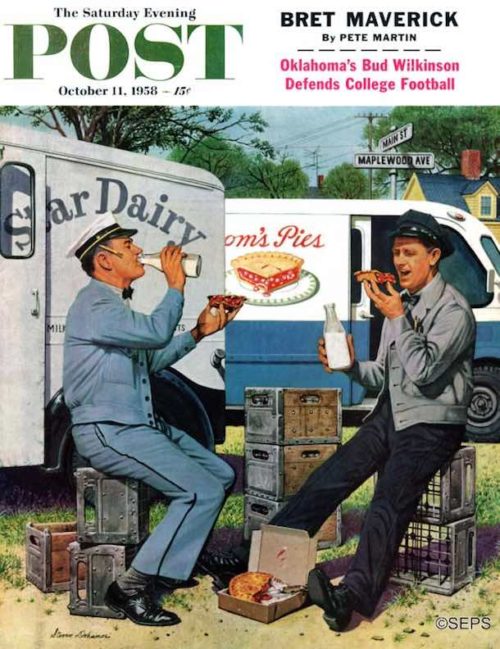
Stevan Dohanos
October 11, 1958
Pie follows closely on the heels of turkey as the quintessential Thanksgiving dish. These pies plus recipes will inspire your pursuit of pastry.
7. Presidents

By Norman Rockwell
October 29, 1960
From Grover Cleveland to Richard Nixon, The Saturday Evening Post featured many U.S. presidents on its covers in its nearly 200-year history.
8. Celebrating America

John Falter
July 5, 1952
With fluttering flags and steadfast soliders, the Post has honored the land of the free and the home of the brave.
9. Travel Nightmares
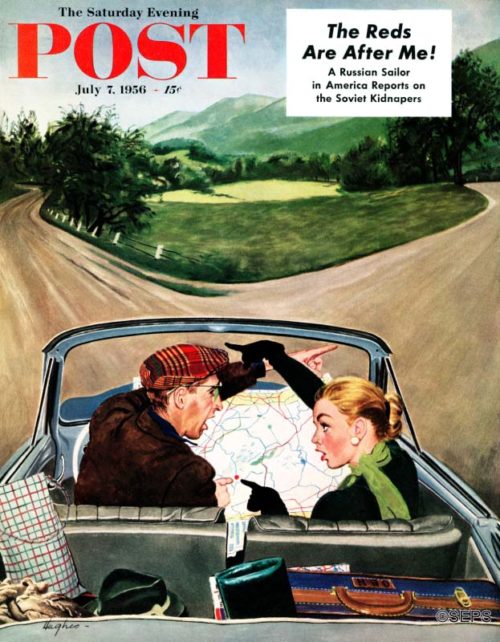
George Hughes
July 7, 1956
These illustrations of jaunts gone wrong might make you re-think that summer road trip.
10. Congrats, Graduates!

McClelland Barclay
June 7, 1930
This moment of accomplishment has made frequent appearances on our covers, starting more than a hundred years ago.
Cover Collection: Back to School
Classrooms may have changed from pencils to PowerPoint, but the Saturday Evening Post has always been there to witness sending our kids back to school.

Robert C. Kauffmann
September 11, 1937
Robert C. Kauffmann painted five covers for the Post, on a variety of subjects from pets to water skiers. With their backs to the viewer, we can only guess what these two are feeling about the first day of school.
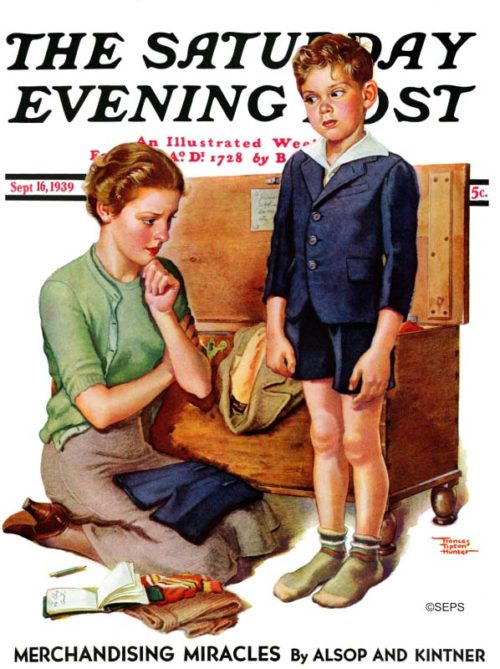
Frances Tipton Hunter
September 16, 1939
Frances Tipton Hunter was one of the most nationally recognized artists in Post history, depicting childhood in a style similar to Norman Rockwell. Most kids grow about 2 inches each year, so this mother likely has a lot of work ahead of her.

Stevan Dohanos
September 2, 1944
This is one time when the kids look happier than the dogs do about going to school.

Stevan Dohanos
September 7, 1946
When Stevan Dohanos painted his picture of the first day of school, the children were brimming with excitement—not because they were posing for a cover, but because the day in question was a great day indeed. It was actually the last day of school, in June.

George Hughes
September 11, 1948
Artist George Hughes painted this scene at Bennington College, in Vermont, which operates a nursery school. “Do you ask me if I have any children of my own?” Hughes mutters. “Only five girls. The one who is crying on the cover is, of course, mine.”

George Hughes
September 6, 1952
If artist George Hughes hadn’t stationed the young lifesaver on that corner, would that man have stepped dreamily into the street, just missed being nicked by the car, and then blamed it in loud words on the driver?
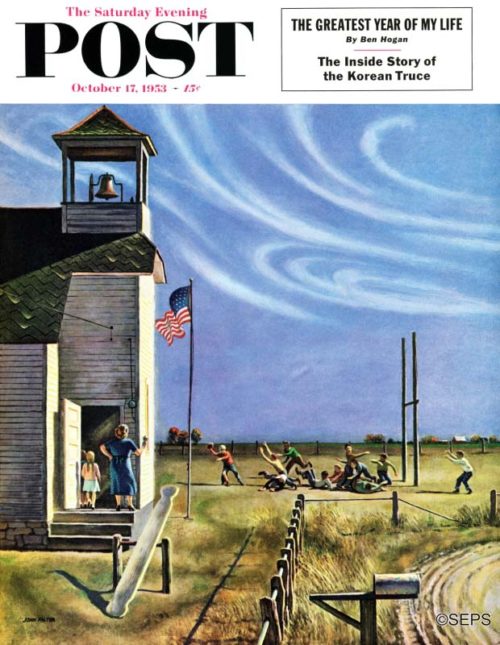
John Falter
October 17, 1953
Regarding that impending touchdown, we bet the teacher knows enough football to rule it illegal—ball was snapped after the school bell rang.

Thornton Utz
September 6, 1958
Artist Thornton Utz vows that when he was very little he liked school so much that he asked his folks if he couldn’t also go to night school. In time he got over that aberration.

Amos Sewell
September 12, 1959
In mother’s ears is a faint, faraway ringing—would it be an echo of the youthful din that has dinned in her ears all summer, or does she think she hears what she is merely imagining, a school bell ringing? Anyway, peace.
Cover Gallery: Travel Nightmares

Stevan Dohanos
July 31, 1948
[From the editors of the July 31, 1948 issue of the Post] While most of the country was sitting around complaining about the rain, Stevan Dohanos was watching the sky anxiously, wondering if we would ever get over a stretch of good weather. He started this cover while taking a vacation in Martha’s Vineyard, Massachusetts. Friends posed for him, the sun was shining brightly. Dohanos went home to Westport, Connecticut, sure that whole summer would be fair. “I had a marvelous break,” he said. “It rained for three days straight. I could go out any hour of the day and get rain research.” He added gratefully that “one man’s nuisance is an artist’s gain.” We hope readers who get soaked will remember that while it may be raining rain to them, it is raining research to an artist.
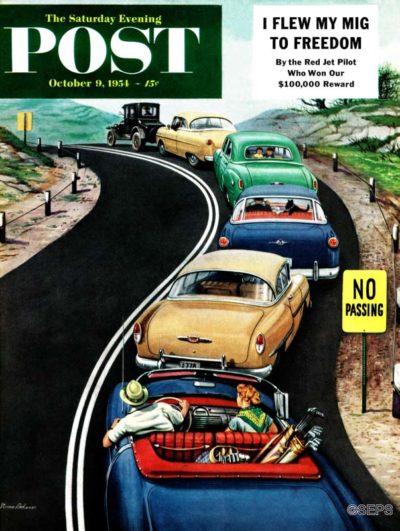
Stevan Dohanos
October 9, 1954
[From the editors of the October 9, 1954 issue of the Post] Grandpa and Grandma Chugchug, bless their elderly souls, are hurtling along on a holiday joyride. To which the subsequent motorists might well add, “And more power to them!” Oh, well, let the dammed-up itinerants repress their damns, for they’ll fetch loose in time, though not when the no-passing zone ends, for them fourteen vehicles will approach from the other direction. Now, who is right in this clash of desires: the people who want to get someplace, or the two who are where they want to get, out in the green land leisurely absorbing the beauty of the placid hills? Maybe both conditions have virtue—like the time Mr. Dohanos got stuck while trying to catch a train. He thought up that cover while awaiting the next train.
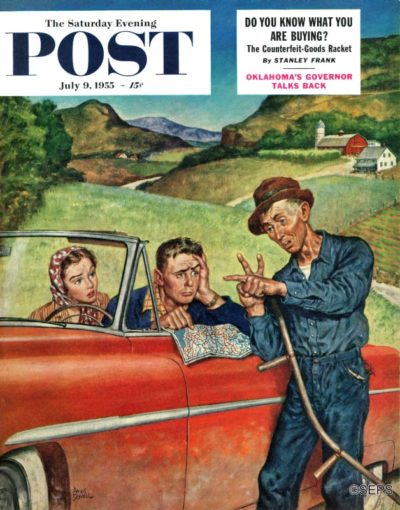
Amos Sewell
July 9, 1955
[From the editors of the July 9, 1955 issue of the Post] John J. Pathfinder is lost, and his wife is accompanying him. With the gallant pioneering instinct which has made America great, he took a short cut between Points A and B, and see what soul-soothing scenery he has found. The helpful scyther is telling him to turn cast beyond the second creek, then bear south just past a pasture of black and white cows, hut Pathfinder is still lost, having forgotten how Scyther said to get to the second creek. If he had heeded his wife’s counsel that short cuts tend to be long cuts, Mr. Sewell wouldn’t have had a cover; besides, men don’t do that anyway. Well, as lost souls wander in circles. Pathfinder probably will come out at Point A where he started, and won’t that send him into gales of laughter!

George Hughes
July 7, 1956
[From the editors of the July 7, 1956 issue of the Post] The way for a loving husband and wife to resolve a conflict like this is to toss a coin; then, when they find they are on the wrong road, both can talk to the coin, which has a phlegmatic personality and won’t care. Unhappily, one of these helpmates will prevail over the other; then, after the road proves wrong, conversation will be renewed, a total of two conflicts. Shouldn’t that man do the steering and let his wife navigate, in as much as nobody can think clearly under a cap like that? Anyway, let us hope that after they’ve been lost a while longer, they will see the drollery of their predicament, and laugh, and savor its humor, but this is a forlorn hope. As those people aren’t illustrator and Mrs. G. E. Hughes, what they are doing with G.E.H.’s suitcase is incomprehensible.
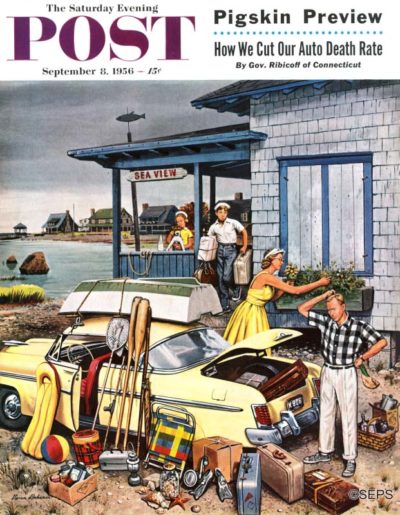
Stevan Dohanos
September 8, 1956
[From the September 9, 1956 issue of the Post] A vacation is wonderful, except to come home from. Well, pop, skip the head scratching; whisk the stuff in, and let’s go. Time’s a fleeting; 175 miles wend ahead on the road map; and if that sky isn’t cooking up an all-day precipitation, maybe there’ll only be a brief nor’easter with gusts up to fifty mph. When pop gets home, will he find his grass eight inches tall? That’s a mean, heartless thought, which is hereby withdrawn with apologies. Kind thought: happily it hasn’t occurred to mother that if she transplanted her flowers into peach baskets, they might bloom at home for many a day. Why doesn’t pop turn that boat over, dump all the debris in there, batten raincoats over it, and stop fooling with his head? Because then Steve Dohanos wouldn’t have a cover.
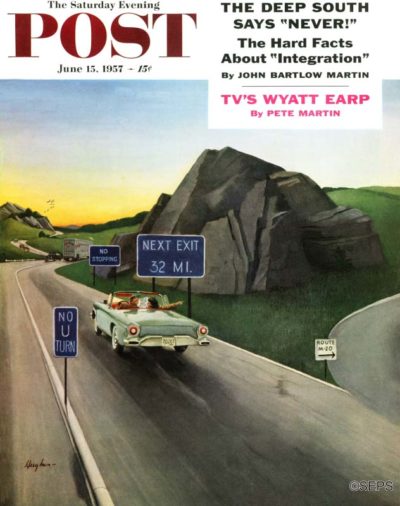
George Hughes
June 15, 1957
[From the editors of the June 15, 1957 issue of the post] High-speed pikes are wonderful inventions, except for a few bugs that need to be ironed out, such as exit signs moving by too fast. To go along with George Hughes’ trouble-making, let’s assume that Mr. and Mrs. Tripp ran low on petrol some miles ago, had to exit into the hinterland to raise a gas pump, and now are unfashionably late as guests at the home of Mr. and Mrs. Waite, away over that away via Route M-20. Should Mr. T. back up, thus enraging pilots of gasoline thunderbolts behind him, and mayhap landing himself a ticket? Should he, with keen regret, proceed ahead 32 miles? Or should he throw cautionary signs to the winds, turn right beyond the rocks, drive gallopy-gallopy across the greens ward, and beat it hell-for-rubber up old M-20? Real moot questions, eh?
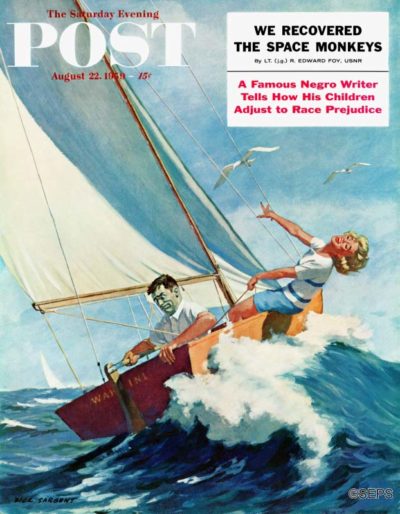
Richard Sargent
August 22, 1959
[From the editors of the August 22, 1959 issue of the Post] “A life on the ocean wave, a home on the rolling deep.” She is having the time of her life, but he is not at home there at all. Indeed, Mr. Tiller is not in good health, and the smartest tack he can take is to tell his lady fair he just remembered an important business appointment on shore. Artist Dick Sargent heartlessly churned up those waves to turn his man gray-green, for when Dick sketched a sailor on Long Island Sound, the water was humane, and the man looked fine—so did a pretty model who was with him. After they landed, the girl turned gray-green—and that’s a switch. Originally Mr. Tiller was located on the far side of that boat, but Sargent moved him for fear he’d tip the whole shebang over. Dick’s a good sailor; he didn’t get sick painting this.
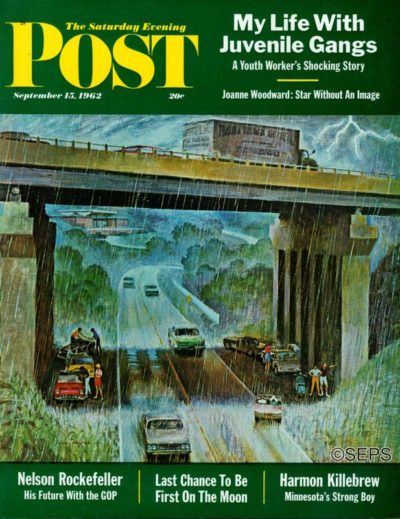
John Falter
September 15, 1962
[From the editors of the September 15, 1962 issue of the Post] Part of the fun of owning a sports car stems from coping with minor inconveniences such as having to put up your top in a sudden rainstorm. Artist John Falter approached this “fun” with feeling. Once he owned a sports car himself—a 1947 English Singer Drop-Head Coupe with self-canceling trafficators. It wasn’t waterproof.